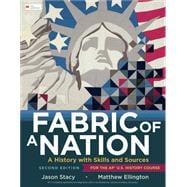The only AP® U.S. History book that weaves together content, skills, sources, and AP® exam practice is back and better than ever.
AP® U.S. History is about so much more than just events on a timeline. The Course Framework is designed to develop crucial reading, reasoning, and writing skills that help students think like historians to interpret the world of the past—and understand how it relates to the world of today. And Fabric of a Nation is still one of the only textbooks that covers every aspect of this course, seamlessly stitching together history skills, sources, and AP® Exam practice. In this new edition, we make it easier than ever to cover all of the skills and topics in the AP® U.S. History Course and Exam Description by aligning our content to the Unit Topics and Historical Reasoning Processes of each Period.
An Accessible, Balanced Narrative
There’s only so much time in a school year. To cover everything and leave enough time for skill development, you need more focused content, not just more content—and to be most effective, skills development should be accessible and placed just where it is needed. Within the narration are AP® Skills Workshops and AP® Working with Evidence features that support students as they learn the history and prepare to take the AP® Exam. Fabric of a Nation delivers a thorough, yet approachable historical narrative that perfectly aligns with all the essential content of the AP® course. An up-to-date historical survey based on current scholarship, this book is also easy to understand and fun to read, with plenty of interesting details and a crisp writing style that keeps things fresh.
Perfectly Aligned to the AP® Scope and Sequence
Fabric of a Nation has an easy-to-use organization that fully aligns with the College Board’s Course and Exam Description for AP® U.S. History. Instead of long, meandering chapters, this book is divided into smaller, approachable modules that pull together content, skills, sources, and AP® Exam practice into brief 1- to 2-day lessons. Each module corresponds with a specific unit topic in the course framework, including the contextualization and reasoning process topics that bookend each time period. This approach takes the guesswork out of when to introduce which skills and how to blend sources with content—all at a manageable pace that mirrors the scope and sequence of the AP® course framework.
Seamlessly Integrated AP® Skill Workshops for Thinking and Writing Skills
Inspired by the authors’ classroom experience and sound pedagogical principles, the instruction in Fabric of a Nation scaffolds learning throughout the course of the book. Every module offers an opportunity to either learn or practice new skills to prepare for each section of the AP® Exam in an AP® Skills Workshop. As the book progresses, the nature of these workshops moves from focused instruction early on, to guided practice in the middle of the book, and then finally, to independent practice near the end of the year.
Fabric of a Nation was designed to provide you and your students everything needed to succeed in the AP® US History course and on the exam. It’s all there.
AP® Exam Practice: We Boast the Most Material
Every period culminates with AP® Practice questions providing students a mini-AP® exam with approximately 15 stimulus-based multiple-choice questions, 4 short-answer questions, 1 document-based essay question, and 3 long-essay questions.
Additionally, a full-length practice exam is included at the end of the textbook. Because the modules in this book are divided into periods that perfectly align to the AP® U.S. History Course and Exam Description, it’s also easy to pair Fabric of a Nation with the resources on AP® Classroom. Each textbook module can be used with the corresponding AP® Daily Videos and Topic Questions while the AP® Exam Practice at the end of each period can be supplemented with the Personal Progress Checks from AP® Classroom.








